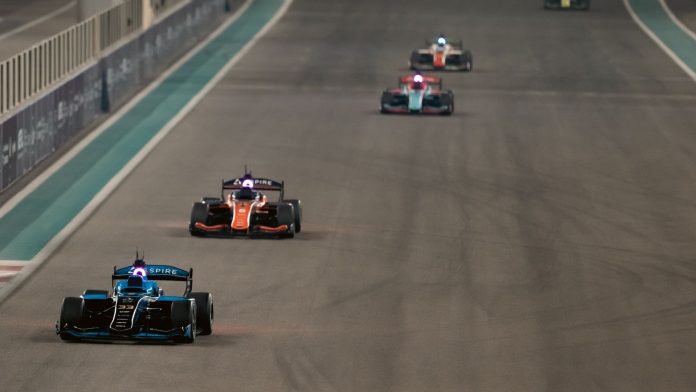The Abu Dhabi Autonomous Racing League (A2RL) staged what organizers called a landmark event for artificial intelligence and robotics, as six fully driverless racecars competed head-to-head in a world-first Grand Final at Yas Marina Circuit.
Germany’s TUM team won the championship title on Saturday (November 15) night in a race covered by Interesting Engineering.
The race featured fast-paced battles, bold AI strategies, and a significant mid-race crash that changed the standings.
The autonomous race
TUM started from pole position but immediately faced pressure from Italy’s Unimore, whose car demonstrated one of the fastest autonomous race paces seen in the series to date.
Unimore closed the gap within the opening laps, executing an overtake on Turn 6 before the end of Lap 2.
What followed was a sustained, high-speed duel between the two teams that lasted more than half the race, with both cars regularly exceeding 250 kmph (155 mph) and staying within one second of each other.
The battle tightened at the midpoint of the 20-lap contest as the leaders approached back-marker traffic. While attempting to overtake Germany’s Constructor team for sixth place, the Unimore car collided with the rear of the slower vehicle mid-corner.
Both cars went off the track, allowing TUM to reclaim the lead uncontested. The German team held that advantage through the remaining laps to secure the championship victory. Despite the collision, Unimore was awarded the Fastest Lap Award for the event.
The award
The awards were presented by His Highness Sheikh Zayed bin Mohamed bin Zayed Al Nahyan; His Highness Sheikh Mohammed bin Sultan bin Khalifa Al Nahyan, Vice Chairman of the Abu Dhabi International Marine Sports Club and Chairman of the UAE Marine Sports Federation; and His Excellency Faisal Al Bannai, adviser to the UAE president and secretary general of the Advanced Technology Research Council.
Al Bannai, who helped conceive the autonomous racing initiative, said the event represented a convergence of engineering disciplines under extreme conditions.
“A2RL shows what happens when bold ambition meets scientific discipline,” he said.
“It is more than a race; it is a testbed accelerating the future of autonomous systems while building public trust in the technologies that will soon move through our cities, skies, and industries. What unfolded on track reflects the power of global talent, rigorous research, and the UAE’s conviction that breakthroughs happen faster when you invite the world to innovate with you.”

TUM team principal Markus Lienkamp said the outcome aligned with the team’s expectations for a close contest with Unimore.
“We expected a tight battle from the beginning,” he said. “They have been getting faster in every test session, especially on cold tires. We thought they would overtake us early, and we would regain ground as temperatures improved. Of course, we hoped the fight would continue all the way to the end, but tonight we showed the rapid improvement and professional capability of the teams in this championship.”
The crash
Unimore team principal Marko Bertogna said his team’s performance demonstrated the growing maturity of autonomous racing systems, even if the finish was disappointing.
“Our speed, our overtake, all showed the professional level that we have reached,” he said. “Even a human racing driver would not have been able to avoid the collision we had. This is just the nature of high-performance racing. I’m incredibly happy about the technological result, but of course less happy about the final result.”

Now in only its second season, A2RL has advanced rapidly as a platform where motorsport intersects with AI research and autonomous mobility development.
Organizers refer to the competition as “science in the public domain,” with algorithms and hardware tested under pressures not achievable in conventional laboratory research.
In the weeks leading up to the final, teams reported that their autonomous racecars had not only closed the performance gap with human-driven benchmark laps but, in some sessions, surpassed them, a milestone for the field.
Saturday’s Grand Final, which featured TUM, Unimore, Kinetiz (UAE), TII Racing (UAE), PoliMOVE (Italy), and Constructor (Germany), was the largest autonomous racing event held to date.
Officials said the results will inform ongoing research on autonomous mobility, perception systems, decision-making algorithms, and high-speed robotics, all of which are tested under race conditions where errors are visible, immediate, and consequential.






